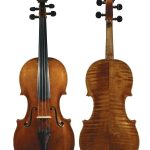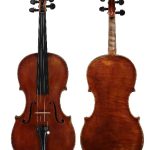The commercial relationship between G.B. Guadagnini and Count Cozio di Salabue allowed the luthier greater freedom to experiment. Alberto Giordano and Barthelemy Garnier examine a 1773 viola to show how the 62-year-old maker continued to adopt new methods and ways of working in this period
In 1816, the famed collector Count Ignazio Alessandro Cozio di Salabue sold a number of instruments to his friend Carlo Carli, a Milanese banker. In the inventory he wrote: ‘the best viola of mine made by Giambattista Guadagnini [in] 1773; joined back with light flames, fine front of one piece, the beautiful f-holes with almond [oval] holes, the bold scroll.’ More than 40 years after purchasing it, the Count was still fond of this viola, one of the two made for him by Guadagnini and among the very first batch of instruments acquired by the Count. The agreement between the young aristocrat and the violin maker was signed on 28 December 1773, but the collaboration had started earlier: the six violins and two violas were a significant part of Guadagnini’s production for that year. They were made during the mourning period for the death of Charles Emmanuel III of Savoy, King of Sardinia, during which any theatrical or musical performance was prohibited. Guadagnini and his family arrived in Turin from Parma in 1771. The capital of the Kingdom of Sardinia was the right choice for many reasons: Turin in the second half of the 18th century was going through a significant expansion that sprawled over the medieval old town.
King Charles Emmanuel had consolidated the territory after the War of the Austrian Succession, and the population grew from 60,000 in 1741 to 90,000 in 1790. Musical activity flourished, not only in the Royal Chapel (established in the 15th century) and in the main theatres, but also in chamber music settings
involving wealthy amateur players. The growing market for musical instruments in France could have been attractive for Guadagnini as well; moreover, there were still no professional violin makers in town, only makers of plucked instruments. In 1773, through the middleman Giovanni Michele Anselmi, Guadagnini signed a contract with Count Cozio, then only 18 years old. It stipulated that the maker would deliver a considerable number of instruments in return for a regular income. Some time later, the Count gradually pushed the maker towards a more Cremonese style of work; but in the short term it gave Guadagnini a new freedom to experiment in his making. This is borne out in the viola shown here: both the mould and the design are quite different from the violas he made in Parma. Although oriented towards the contralto size of Antonio Stradivari, it shows Guadagnini’s innovative approach. The length of the back (taken with a flexible ruler) is 401mm and the width of the body is enlarged, especially at the C-bouts. This makes a difference to the placing of the f-holes: the distance between the upper eyes is extended up to 56mm, while the flat and high archings are conceived for getting the strongest sound possible for this size. With the growth in activity of professional musicians in theatres, music halls and aristocratic houses, the viola market had changed significantly in the second half of the 18th century: viola players were often employed non-salaried, and many were violinists who alternated between the two instruments. Today it is rare to come across an Italian viola bigger than contralto size, and luthiers were often asked to build violas less than 400mm, even down to 375mm. In addition, the role of the viola in music composition was becoming more complex, especially in chamber music, so players wanted a more manageable instrument.
The last inventory of Cozio’s collection was drawn up in 1841, the year after his death, by which time Guadagnini had made more than 50 instruments for the Count. According to Duane Rosengard most of them, including the two violas, were still in the house of the Carli family. Carlo Carli, a talented amateur violinist, was friends with both the Count and Nicolò Paganini, who in 1817 bought a fine 1724 Stradivari violin from Cozio (with Carli’s brokerage). The story of the group of instruments made by Guadagnini for Cozio between around 1773 and 1777 sounds surprising, since just a few violins and a cello were sold in the following 60 years. Many of these were still in pristine condition: in this group there was at least one violin in the white and many were unfitted. In 1816 a cello and a violin in the white were varnished by Carlo Mantegazza, who also modernised the two violas by resetting their necks. Cozio wasn’t successful in selling Guadagnini’s instruments, and it seems they looked unattractive to players, since so few were sold. The two violas, along with the best part of the collection, remained unsold. In 1839, the year before the Count’s death, Carlo Carli’s son Giuseppe made an agreement with Luigi Tarisio for the sale of six violins. The agreement was concluded two years later for quite a cheap price. Cozio’s daughter Matilde inherited the collection, and after her death in 1853, the estate passed to her cousin Marchese Rolando dalla Valle, who succeeded in selling the collection: Cozio’s biographer Federico Sacchi wrote that only four bowed instruments, including an unspecified Guarneri, were left. At this point the collection was dispersed and the immediate whereabouts of the ‘Cozio’ viola became unknown. The viola reappeared in the US in the 20th century. Violin dealer and researcher Claire Givens has successfully traced its recent history since the first known modern owner, Mrs. Elsa Johanna Frank of Milwaukee (1885–1987). She was the daughter of Louis Frederick Frank, a dermatologist and a philanthropist, a founder of the Wisconsin Conservatory of Music and the Milwaukee Musical Society. The instrument was probably bought by the father in a sale by Puttick & Simpson in 1899. Elsa Frank kept the viola until 1936 when she gave it on consignment to Rudolph Wurlitzer: it was sold in 1937 to Dr William Lawson Mann who kept it until his death in 1947, then in 1948 it was acquired by Lyon & Healy in Chicago. Edmund V. Bukolt from Wisconsin is the third documented private owner: he was a violinist, businessman and philanthropist. In 1965, the year before his death, he turned the ‘Cozio’ over to a philanthropic organisation that still continues today. Givens notes that Lyon & Healy sold the viola as the ‘Sovereign’: the Cozio carteggio was still unavailable, and the provenance from the Italian nobleman was for a long time forgotten. The viola is now back in Cozio’s home town of Casale Monferrato, housed in the collection of Giovanni Accornero.
Materials and archings
It was not a habit of Giovanni Battista to make one-piece bellies, but from the start of his collaboration with the Count there were a few instruments made this way. The spruce looks to be of quite cheap quality, with a wide and slightly contorted grain; however, it is also of strong consistency and great tonal features. For the back, Guadagnini used a light-figured maple showing some flaws in the grain in the lower sides. The plate archings are quite high: 210mm on the front and 195mm on the back and they remain solid and straight to the edges, never going hollow along the purfling area. If the material used can be considered cheap, nonetheless the workmanship of the ‘Cozio’ viola is of great quality and care. CT scans produced by the Elettra Sincrotrone Trieste show how carefully the carving was undertaken: the archings are perfectly cut and finished, the interior appears to be in an excellent state of conservation, and it bears a number of marks of the maker. The thickness on the front is quite full around the f-holes (up to 3.8–4mm on the bass side) and it decreases along the centre line (figure 1). In the back the thickest point is of 4mm and then graduation decreases down to 2mm on the side area.
Edgework and purfling
The edgework has a personal and bold look, owing to the thickness of the purfling and its position: it is set at 4.5mm from the edges, giving a strong charm to the outline. The purfling is entirely made from walnut with a general thickness of about 1.4mm: the ‘black’ strips are c.0.4mm and the ‘white’ 0.9mm. The corners are made without extensions and all along the run a few knife cuts are visible, testifying to a certain rushing of the channeling work (figure 2a). It seems likely that Guadagnini chose walnut for its ease of use, as it is easy to bend and very flexible, perfect for a fast job. In other instruments, the softness of the purfling can sometimes cause it to break when inserted in the channel, which may have become tighter due to the moisture of the hot glue. The thickness of the edges varies greatly all along the run: it is especially high on the button area of the back (figure 2b), where it gets up to 6mm, and high in the middle of the C-bouts (4.6mm on the front, 4.2mm on the back). Conversely, the scoop is quite flat and only lightly hollowed, and gently worked.
F-Holes
When looking at the viola the viewer can be deceived by its size, since it seems a little bigger than it is. This is partly due to the f-hole placement and by the C-bouts, which Guadagnini deliberately enlarged. As a result of the placement, the viola’s response is quite impressive and the sound particularly focused. The design is still in the typical Guadagnini tradition, with the ‘almond-shaped’ eyes of Cozio’s description; the f-holes are the result of fast, self-confident knifework (figure 3), showing a few flat lines, a little chipping in a lower eye and rapidly cut nicks. The fluting is well scooped and connected to the arching, finished with a scraper; the lower eyes appear to be slightly rounded by abrasive action, probably undertaken before the varnishing of the instrument.
Scroll
If the soundbox has quite a bold look, the scroll is of a quite slim design: Guadagnini abandons Stradivari’s old viola scroll design with flanks for a more convenient violin shape. The usual pinpricks used for the tracing are particularly marked and deep, even below the eye, suggesting that maybe a second tracing was done during the carving. On the side, the cut gets deeper along the turns and the use of a small curved gouge is visible; the chamfer is quite thin, probably cut with a small chisel and rounded at a later time (figure 4). On the front one can see the straight design of the pegbox, a light scribed centre line and the scoop of the fluting cut with a knife until the end of the throat. From behind, one can see the oval and irregular button, carelessly connected with the spine, demonstrating that the chamfer was cut after the scooping. Beneath the varnish a few scratches produced by an abrasive action are also visible in the scoop.
Varnish
A coat of yellow–orange varnish still completely covers the viola: laid over a brilliant and reflective ground, the varnish appears today in very fine condition, still admirable for the generous paste, so elastic and resistant.
Label
The original label lies undisturbed on the back of the viola; the paper is of good consistency with light perpendicular ribs (figure 5). The print has left quite a deep impression on it, with light smears of ink around a few letters. The paper seems to have been cut out with a fast knife cut. Guadagnini was always very concerned about promoting himself, and from his arrival in Turin and his collaboration with the Count onwards, he would brag about his origins in Cremona and his direct link with the renowned Cremonese makers of the past. In the Turin label one can see the ‘T’ below the monogram and a cross above: Guadagnini turned from the Patriarchal cross used in Parma to a Greek cross that more readily evokes the lutherie traditions of Cremona – quite ironic given the departures he took from those traditions in making this exceptional instrument.
Barthelemy Garnier uses clues from the viola’s interior to examine how Guadagnini made the instrument
During Guadagnini’s Parma period, it seems that he made a radical change in his construction method by changing the type of mould used. Specifically, it appears to change from the Cremonese mould to the Italian mould. This change would have occurred almost halfway through the life of the master – an important, unexplained change, and one that requires an in-depth study. As a consequence of this change, Guadagnini would have done away with all his existing moulds, both violin and viola, creating new moulds using the Italian method (figure 1). Thanks to the exceptional condition of the 1773 instrument, reliable information can be gathered from it. The traces of work that remain inside the instrument make it possible to propose several hypotheses regarding the method of construction used by Guadagnini in this period. The corner-blocks are positioned more towards the C-bouts, demonstrating the use of the Italian mould as opposed to the Cremonese. This hypothesis is confirmed by the absence of the typical vertical planes of wood visible on the corner- blocks of the Cremonese school. All four corner-blocks have a uniform width of 33mm, suggesting Guadagnini used four pieces from the same block of wood. The growth-ring pattern and the number of rings match perfectly across the corner-blocks. The marks left on the inner rib surfaces highlight the fact that the linings, usually made of willow, were finished while the form was still present. The mould used for this viola appears to have been just over 1cm thick and cantered on the ribs. On the edge of the corner-block, there is a small blob of old glue and some wood fibres belonging to the original mould (figure 2). The setting of the linings into the block, present only in the C-bouts (typical of Cremonese school), is characteristic of Guadagnini’s work. This joint is made with a lateral incision using a knife, and it was Guadagnini’s habit at the time
to create a kind of window, leaving a part of the lining visible (figure 3). A deep incision can be seen on one of the blocks (probably accidental), which goes beyond the joint (figure 4). This cut shows that the setting in of the lining was probably made when the block was already largely trimmed. Typically, after the removal of the mould from the ribs (a very delicate operation with the Italian mould compared with that of the Cremonese), Guadagnini would trim the C-bout blocks, perhaps to make them look more like those of Cremona instruments (figure 5). In the instrument in question, however, the blocks were not modified. The bottom-block, still original, is characteristic of Guadagnini’s work. He typically used willow or spruce, and used willow for this viola. The bottom-block, finished with a chisel, has two lateral planes on the sides. On the gluing surface a pair of V-shaped incisions can be seen, which were probably used to establish the centre of the instrument. These cuts are seen in other Guadagnini instruments.
Copyright © 2022 Alberto Giordano, The Strad magazine All rights reserved






